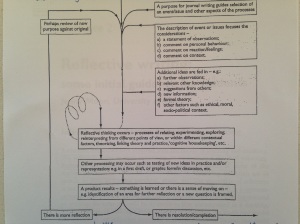As part of our Industrial Media Assignment, we had the task to read the “writing/reflectively”reading. While the entire piece made a superb read, I am sharing the two points which got me very interested and worth keeping with me forever and passing on!
It was indeed interesting to note that writing a reflection is indeed process driven, which, if mapped meticulously can lead to immense learning and thinking. The process clearly starts with the purpose, followed in ascending order by:
• Description of the event
• Further observations about the event with regards to ideas and suggestions from others
• Exploring and interpreting from different points of view and hence following “cognitive housekeeping” which means sorting out things!
• Leading to a productive learning or a sense of moving on which leads to a completion or a resolution.
Until I read this article, I had never imagined that I could actually process reflections with a resolution more productively by just following the process! Perhaps now, this article has enabled me to do so,provided I followed the processing of reflections in the manner shared above. This actually gave a method to my madness of writing reflections. I sincerely suggest adherence to this map of reflective writing for everyone looking to” learn to reflect”
The second other interesting part was The Presentation: exercise in reflective writing.
Just to give a back ground, Marianne had to make a presentation on the project she was working on which was pertaining to creating a new database for the Management information system. While she had done a good presentation in the past, she decided to blindly follow a colleague example by using a powerpoint to present and add numbers to showcase her ability to analyse.However, in the end she felt that all this did not cut ice with the audience and she felt she failed miserably in her attempt for a good presentation. Three versions of her reflective writing were shared.
To me after going through the three versions of reflective writing on a presentation by Marianne, I could clearly understand the criteria to do an in depth reflective writing. As I went through different versions and what was lacking in each, I understood what needed to be included to add evidence of reflection. This explanation of ingredient inclusion for reflective writing could not have been better!
It was truly amazing to learn that one can add to the true meaning of a reflection with an internal dialogue, which is very critical since it triggers the questioning and deliberations of ideas, views of oneself and then of other. One can further add more relevance by standing back from the event with the willingness to be critical of action. In this manner relevant and helpful details are explored, which opens up learning opportunities. After all we reflections are the true catalysts and means for learning!
I am fortunate to have gone through this insightful reading on writing reflections and just cant wait to implement these valuable learnings for my next reflection!
